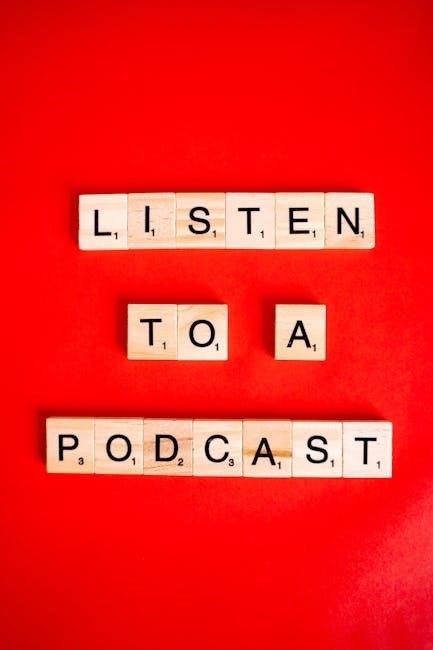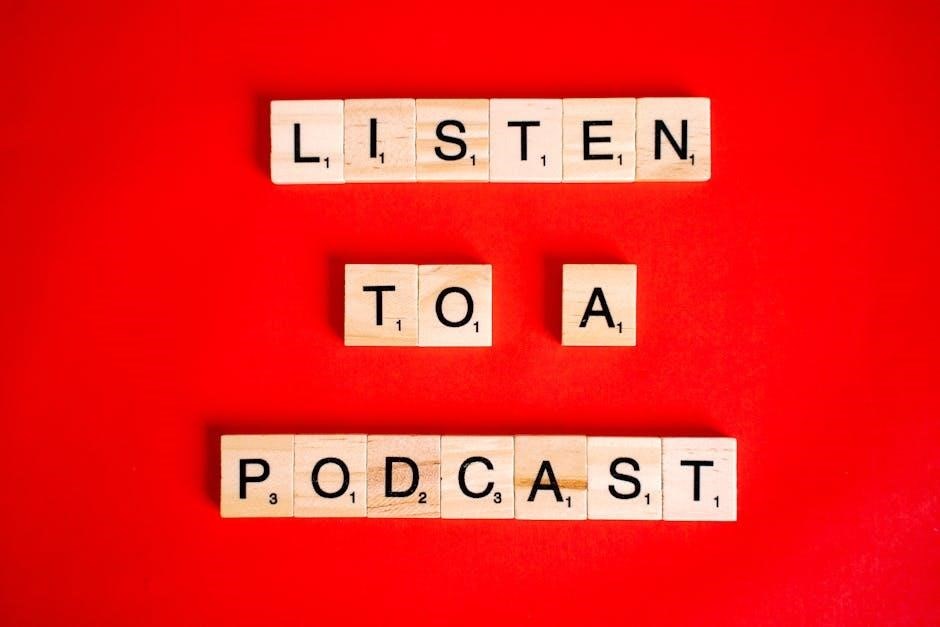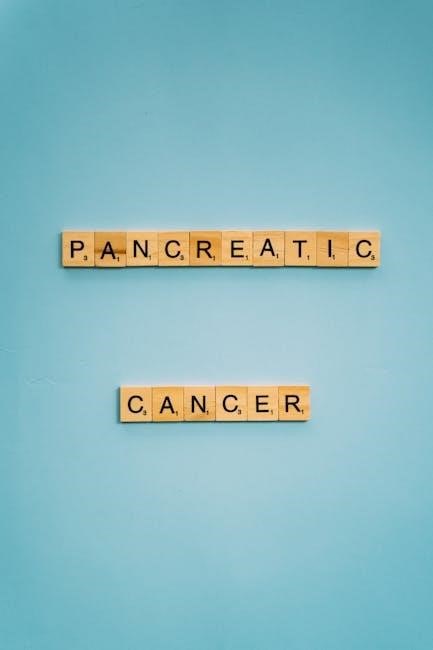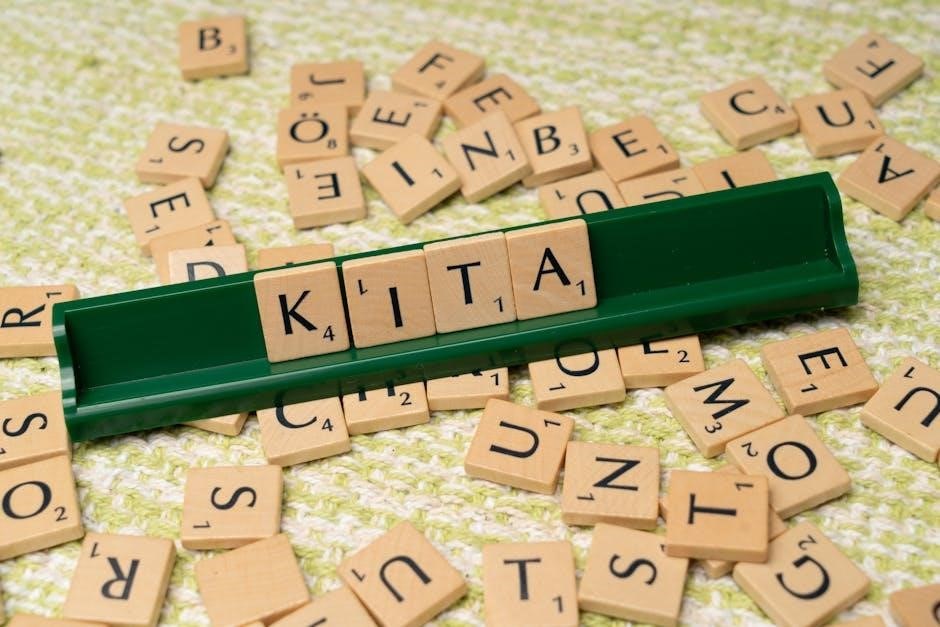Kindergarten spelling introduces young learners to foundational literacy skills through engaging activities. PDF resources offer interactive exercises like tracing‚ matching‚ and word building‚ focusing on CVC words‚ sight words‚ and rhyming patterns. These tools make learning fun and effective for early spellers.
Importance of Spelling in Kindergarten
Spelling in kindergarten is crucial for building foundational literacy skills. It introduces young learners to letter-sound relationships‚ enabling them to decode and encode words. Early spelling practice enhances phonological awareness‚ a key skill for reading and writing. Activities like tracing‚ matching‚ and word building foster fine motor skills and hand-eye coordination. By mastering basic spelling concepts‚ children gain confidence and develop a strong foundation for future academic success. Spelling also encourages creativity and critical thinking‚ as students explore word patterns and rhymes. These skills are essential for overall communication and pave the way for a lifelong love of learning.
Benefits of Using PDF Resources for Spelling Practice
PDF resources for kindergarten spelling practice offer numerous benefits‚ making learning engaging and accessible. They provide reusable‚ printable worksheets that can be used repeatedly‚ reducing costs and waste. These resources often include interactive activities‚ such as tracing‚ matching‚ and fill-in-the-blank exercises‚ which cater to different learning styles. Many PDFs feature colorful illustrations and engaging layouts‚ capturing young learners’ attention and fostering a love for spelling. Additionally‚ they are easily accessible online‚ allowing parents and teachers to download and print them at home or in the classroom. PDF spelling resources also cover a variety of word types‚ such as CVC words‚ sight words‚ and word families‚ ensuring a well-rounded learning experience. Their structured format helps track progress and reinforces foundational skills‚ making them an invaluable tool for early literacy development.
Overview of Spelling Word Lists for Kindergarten
Spelling word lists for kindergarten are carefully curated collections of words designed to introduce young learners to foundational literacy skills. These lists typically include simple‚ high-frequency words that align with early reading and writing development. They often feature CVC (consonant-vowel-consonant) words‚ sight words‚ and basic vocabulary related to everyday themes‚ such as family‚ animals‚ and colors. Organized by difficulty and phonetic patterns‚ these lists help children build confidence in recognizing and spelling words. Many kindergarten spelling lists are structured to reinforce phonemic awareness‚ rhyming‚ and word families‚ laying the groundwork for advanced literacy. Available in PDF formats‚ these resources are easily accessible and printable‚ making them a convenient tool for both classroom and home use. They serve as a stepping stone for children to master essential spelling skills and develop a strong foundation for future academic success.

Types of Spelling Words for Kindergarten
Kindergarten spelling word lists are age-appropriate collections of words designed to help young learners master basic spelling skills. These lists often include high-frequency sight words‚ simple CVC words‚ and thematic vocabulary. Organized by sound patterns and difficulty‚ they introduce foundational phonics and word recognition. Many lists incorporate word families‚ rhyming words‚ and basic blends to reinforce early literacy. Available in PDF formats‚ these resources are easy to print and use‚ making them ideal for classroom or home practice; They provide a structured approach to spelling‚ helping children build confidence and fluency in recognizing and writing words. These lists are a key tool for teaching spelling in a fun and engaging way‚ supporting young learners as they take their first steps in literacy.
CVC Words and Their Role in Spelling
CVC (Consonant-Vowel-Consonant) words are foundational for kindergarten spelling. These simple three-letter words‚ like “cat” or “dog‚” introduce children to basic phonics patterns. They help learners recognize the relationship between sounds and letters‚ making decoding easier. CVC words are often the first step in teaching spelling because they follow predictable structures‚ allowing young students to build confidence; Many kindergarten PDF resources include CVC word lists and activities to practice writing and reading these words. These exercises often feature tracing pages‚ word matching‚ and fill-in-the-blank games to engage learners. CVC words also lay the groundwork for understanding more complex word patterns later. By mastering these words‚ children develop essential phonological awareness and spelling skills that are crucial for early literacy. They provide a clear starting point for young learners to explore the world of spelling with ease and confidence.
Sight Words and High-Frequency Words
Sight words and high-frequency words are essential for early literacy development in kindergarten. These words‚ often memorized by sight‚ appear frequently in texts and do not always follow phonetic rules. They are included in many kindergarten spelling PDF resources to help children recognize common words quickly. Sight words‚ such as “the‚” “and‚” and “is‚” are foundational for building reading fluency. High-frequency words‚ like “see” and “have‚” are also emphasized to improve decoding skills. These words are often taught through activities such as flashcards‚ word searches‚ and matching games. By mastering sight and high-frequency words‚ children gain confidence in reading and spelling. These words are typically introduced in sets‚ allowing learners to progress at a steady pace. They are a cornerstone of early spelling instruction‚ helping young learners transition from sounding out letters to reading full sentences with ease and accuracy.
Word Families and Patterns in Spelling
Word families and patterns are a cornerstone of kindergarten spelling instruction‚ helping children recognize common letter combinations. Families like -at‚ -an‚ and -in introduce predictable patterns‚ making it easier for young learners to decode and spell words. Spelling PDF resources often include activities that focus on these patterns‚ such as word building exercises‚ matching games‚ and fill-in-the-blank tasks. By identifying and repeating these patterns‚ children develop phonological awareness and spelling consistency. For example‚ once a child learns the -at family‚ they can quickly spell words like “cat‚” “hat‚” and “mat.” These activities also enhance creativity‚ allowing children to experiment with new words within the same family. Mastering word families and patterns lays a strong foundation for reading and spelling success‚ fostering confidence and fluency in young learners.
Consonant Digraphs and Blends
Consonant digraphs and blends are essential for kindergarten spelling as they introduce children to combined letter sounds. Digraphs like “ch‚” “sh‚” and “th” represent single sounds‚ while blends‚ such as “bl” or “tr‚” combine two sounds smoothly. Spelling PDFs often include exercises that focus on these patterns‚ helping children recognize and reproduce the sounds. Activities like tracing‚ matching‚ and building words with magnetic letters are common. For example‚ blending “c” and “h” to form “ch” or combining “b” and “l” for “bl” enhances phonological awareness. These skills are crucial for reading and spelling simple words like “chat” or “blend.” Interactive games and picture sorting activities in PDF resources make learning engaging. Mastering digraphs and blends builds a strong foundation for decoding more complex words as children progress in their literacy journey.
Vowel Sounds and Rhyming Words
Vowel sounds and rhyming words are fundamental in kindergarten spelling PDFs‚ as they help children develop phonological awareness. Activities often focus on identifying short and long vowel sounds‚ such as /ă/‚ /ē/‚ and /ī/‚ in simple CVC (consonant-vowel-consonant) words like “cat‚” “bike‚” and “boat.” Rhyming exercises‚ such as matching words that end with the same sound‚ enhance language skills and prepare children for reading. Spelling PDFs include games like word families (-at‚ -an‚ -in) and picture sorting based on vowel sounds. These resources also incorporate interactive activities‚ such as filling in missing vowels or creating rhyming pairs. By practicing vowel patterns and rhymes‚ children gain confidence in decoding and spelling words. Engaging visuals and hands-on exercises make learning vowel sounds and rhymes both fun and effective‚ laying a strong foundation for future literacy skills.

Popular Spelling Word Lists for Kindergarten
Kindergarten spelling PDFs often feature Dolch Sight Words and Fry High-Frequency Words‚ focusing on common themes like family‚ animals‚ and shapes. Word lists are organized by sounds‚ themes‚ and difficulty to ensure gradual learning and reinforcement of foundational spelling skills.
Dolch Sight Words for Kindergarten
Dolch Sight Words are a collection of high-frequency words that are essential for early reading and spelling. These words‚ identified by Dr. Edward William Dolch‚ are often irregular and don’t follow phonetic patterns‚ making them critical to memorize. In kindergarten spelling PDFs‚ Dolch Sight Words are typically presented in lists‚ flashcards‚ or simple exercises to help children recognize and write them fluently. Activities like tracing‚ matching‚ and word-building games are commonly included to reinforce these words. The kindergarten list includes basic words like the‚ and‚ and is‚ which are fundamental for building early literacy skills. These words are designed to help children develop confidence in reading and spelling‚ laying the groundwork for future academic success. By mastering Dolch Sight Words‚ young learners can focus on comprehension and more complex skills as they progress.
Fry High-Frequency Words for Kindergarten
Fry High-Frequency Words are a curated list of words that appear most commonly in written English‚ organized by grade levels. For kindergarten‚ these words are selected to align with early reading and spelling development. In spelling PDFs‚ Fry words are often presented through engaging activities like matching games‚ word searches‚ and tracing exercises. These resources help children develop instant recognition of these high-frequency words‚ which is crucial for reading fluency. The kindergarten list includes simple words such as a‚ I‚ and see‚ which are foundational for building early literacy skills. Fry words are designed to be practiced regularly‚ and their inclusion in PDF materials ensures accessibility and convenience for both teachers and parents. By mastering these words‚ young learners gain confidence in their ability to read and spell‚ creating a strong foundation for future academic success.
Common Themes in Kindergarten Spelling Lists
Kindergarten spelling lists often focus on themes that are relatable and meaningful to young learners. Common themes include family members‚ animals‚ colors‚ and basic actions. Words like mom‚ dad‚ cat‚ and run are frequently included because they align with children’s everyday experiences. These themes help students connect spelling to real-life contexts‚ making learning more engaging. Additionally‚ many lists incorporate seasonal and holiday-themed words‚ such as snow for winter or pumpkin for fall‚ to make practice fun and timely. By organizing words around these themes‚ spelling PDFs provide a structured approach that builds vocabulary while fostering recognition and spelling skills. This method also helps teachers create cohesive lesson plans and activities that reinforce learning objectives.
Word Lists by Sounds and Patterns
Kindergarten spelling PDFs often organize word lists based on specific sounds and patterns‚ helping young learners recognize and replicate these phonetic structures. Words are grouped by ending sounds‚ such as -at or -an‚ or by vowel patterns like long a or short e. This approach allows children to identify commonalities and apply them to new words. For example‚ words like cat‚ hat‚ and mat are grouped together to emphasize the -at sound. Similarly‚ words with consonant digraphs like ch or sh are grouped to practice these blended sounds. Organizing lists by sounds and patterns makes spelling more systematic and predictable‚ helping kindergarteners build foundational skills and confidence in decoding and spelling words.

Activities and Exercises in Spelling PDFs
Spelling PDFs for kindergarten include engaging activities like tracing‚ matching games‚ and interactive tasks. These exercises make learning fun and help develop essential spelling skills in young children.
Tracing and Writing Activities
Tracing and writing activities are fundamental in kindergarten spelling PDFs‚ helping children develop fine motor skills and letter formation. These exercises often include guided tracing of letters and words‚ allowing learners to practice correct strokes and shapes. Many PDF resources provide dotted letters or words for children to trace over‚ gradually transitioning to independent writing. Repetitive tracing helps build muscle memory‚ ensuring letters are formed correctly. Writing activities also extend to short sentences or phrases‚ reinforcing spelling patterns and word recognition. These exercises are designed to be engaging‚ with colorful visuals and large‚ easy-to-trace fonts. Tracing and writing activities are essential for young learners‚ as they lay the foundation for spelling proficiency and handwriting confidence. Regular practice with these tools helps children progress smoothly from tracing to independent writing‚ fostering a strong connection between spelling and writing skills. These activities are both educational and enjoyable‚ making learning fun and effective for kindergartners.
Fill-in-the-Blank and Matching Games

Fill-in-the-blank and matching games are engaging activities in kindergarten spelling PDFs that enhance word recognition and spelling skills. These exercises typically involve completing sentences with missing letters or words‚ helping children understand context and word patterns. Matching games pair words with pictures‚ definitions‚ or rhyming sounds‚ improving memory and spelling accuracy. Many PDF resources include colorful‚ interactive designs to capture young learners’ attention. For example‚ matching games might ask students to link a word like “cat” with a picture of a cat‚ reinforcing vocabulary and spelling connections. Fill-in-the-blank activities often use simple sentences‚ such as “The ___ is red‚” allowing children to practice spelling high-frequency words like “apple.” These games are designed to be fun and educational‚ making spelling practice an enjoyable experience for kindergartners while building their confidence in recognizing and spelling words correctly. They also encourage critical thinking and problem-solving skills in a playful manner.
Picture Sorting and Labeling Activities

Picture sorting and labeling activities are a fun and interactive way for kindergartners to practice spelling and vocabulary skills. These exercises‚ often found in PDF resources‚ involve matching words to corresponding pictures or sorting words into categories. For example‚ students might sort words like “cat‚” “dog‚” and “bird” under a “pets” category. Labeling activities require children to write words next to pictures‚ reinforcing spelling and recognition. These tasks help develop critical thinking and fine motor skills while making learning engaging. Many PDFs include colorful illustrations and themes‚ such as animals‚ food‚ or seasonal items‚ to keep young learners motivated. Picture sorting and labeling activities also encourage children to connect words with their meanings‚ building a strong foundation for reading and writing. They are an effective way to make spelling practice enjoyable and meaningful for kindergarten students.
Sentence Building and Word Formation
Sentence building and word formation activities are essential for kindergartners to apply their spelling skills in a practical way. These exercises‚ often included in PDF resources‚ involve using magnetic letters‚ letter cards‚ or cut-and-paste worksheets to create simple sentences or new words. For example‚ children might arrange letters to form words like “cat” or “dog” and then use them in short sentences. Word formation activities also encourage students to change letters in words to create new ones‚ such as changing “cat” to “hat.” These tasks help develop phonological awareness and language skills while reinforcing spelling. Many PDFs include guiding questions or prompts to help children think critically about word structures. Sentence building and word formation activities make learning interactive and fun‚ allowing young learners to see how words fit together to convey meaning. This skill is foundational for reading and writing development in kindergarten.

Assessment and Progress Tracking
Regular quizzes and spelling charts help track progress‚ while flashcards provide quick recall assessments. These tools identify areas needing extra practice and monitor improvement over time effectively.
Quizzes and Weekly Assessments
Quizzes and weekly assessments are essential tools for evaluating a child’s mastery of spelling words. These regular checks help identify progress and areas needing extra practice. Teachers can create short‚ engaging quizzes using words from the kindergarten spelling lists‚ ensuring they align with recent lessons. Writing the words on flashcards or incorporating them into matching games makes the process fun and interactive. Weekly assessments also provide parents with insights into their child’s learning journey. By reviewing quiz results‚ educators can adjust instruction to better meet individual needs. Consistent assessment helps build confidence and reinforces spelling skills in a structured manner. Over time‚ these evaluations reveal growth and readiness for more complex words‚ making them a cornerstone of effective spelling instruction in kindergarten.
Tracking Progress with Spelling Charts
Spelling charts are a visual and effective way to track a child’s progress in mastering spelling words. These charts can be personalized to include the child’s name‚ a list of target words‚ and spaces for checking off mastered words. Teachers and parents can use these charts to monitor improvement over time‚ identifying which words need more practice. Color-coding missed or mastered words adds an interactive element‚ making it easier for young learners to see their achievements. Regularly updating the chart creates a sense of accomplishment and motivates children to keep learning. Spelling charts also serve as a clear communication tool between teachers and parents‚ ensuring everyone is aligned in supporting the child’s progress. This simple yet powerful tool fosters accountability and celebrates growth in a way that is both fun and encouraging for kindergarten students.
Using Flashcards for Quick Recall
Flashcards are a versatile and engaging tool for reinforcing spelling skills in kindergarten. They provide a quick and effective way to practice word recognition and recall. Each flashcard typically features a word on one side and its corresponding image or definition on the other‚ making them ideal for visual learners. Teachers and parents can use flashcards to drill high-frequency words‚ CVC words‚ and sight words‚ helping children build confidence in their spelling abilities. Flashcards can be customized to match specific spelling lists and learning objectives. Regular practice with flashcards improves retention and fluency‚ while also making learning fun and interactive. Digital flashcard apps and physical card sets offer flexibility for different learning environments. This method is particularly effective for young learners‚ as it breaks down learning into manageable‚ bite-sized chunks and provides immediate feedback. Flashcards are a valuable resource for fostering quick recall and spelling mastery in kindergarten.
Interactive Activities for Engagement
Interactive activities play a crucial role in making spelling practice enjoyable and effective for kindergarten students. Games like spelling bingo‚ word scavenger hunts‚ and magnetic letter matching are excellent ways to engage young learners. These activities encourage hands-on participation‚ fostering a deeper connection to the words being learned. Digital tools‚ such as spelling apps and online games‚ also provide interactive experiences that cater to modern learners. Collaborative activities‚ like pairing students to spell words together‚ promote teamwork and peer learning. Movement-based games‚ such as hopping to letters or jumping to spell words‚ combine physical activity with spelling practice‚ keeping children motivated. These engaging methods make spelling practice feel like play‚ while reinforcing memory retention and confidence in young learners. Interactive activities ensure that spelling practice is both fun and effective‚ helping kindergartners develop a strong foundation in spelling skills.

Resources and Tools for Teachers

Teachers can utilize PDF guides‚ educational apps‚ and classroom templates to create engaging lessons. These tools offer flexibility and structure‚ making spelling instruction efficient and enjoyable for kindergartners.
Printable Worksheets and PDF Guides
Printable worksheets and PDF guides are essential tools for teaching spelling to kindergartners. These resources provide structured activities such as tracing letters‚ matching games‚ and fill-in-the-blank exercises. Many PDF guides include word lists‚ flashcards‚ and interactive pages that cater to different learning styles. Teachers can customize these materials to suit their classroom needs‚ ensuring engaging and effective lessons. Additionally‚ PDFs are easily accessible and can be printed in various sizes‚ making them ideal for both individual and group activities. They often feature colorful illustrations and child-friendly designs to keep young learners motivated. By incorporating these resources‚ educators can create a fun and structured environment for spelling practice‚ helping students build a strong foundation in literacy. Printable worksheets and PDF guides are versatile‚ convenient‚ and adaptable‚ making them a valuable asset for kindergarten spelling instruction.
Online Interactive Spelling Games
Online interactive spelling games are a dynamic way to engage kindergarten students in spelling practice. These games often feature colorful animations‚ sounds‚ and rewards‚ making learning fun and exciting. Many platforms offer age-appropriate activities‚ such as matching games‚ drag-and-drop exercises‚ and virtual spelling bees. These tools allow children to practice spelling words at their own pace‚ providing immediate feedback and reinforcement. Interactive games also help develop fine motor skills as students interact with touchscreens or keyboards. Additionally‚ multiplayer options encourage collaboration and healthy competition among peers. These resources complement traditional PDF worksheets by offering a digital learning experience that captivates young learners. Online spelling games are accessible from various devices‚ making them a convenient and engaging addition to kindergarten spelling instruction. They foster a love for learning while building essential literacy skills in a playful and interactive environment.
Spelling Bee Word Lists for Kindergarten
Spelling bee word lists for kindergarten are specially curated to introduce young learners to the excitement of spelling competitions. These lists typically include simple‚ high-frequency words that align with early literacy skills. Words like “cat‚” “dog‚” “sun‚” and “hat” are common entries‚ focusing on basic phonetic patterns and sight recognition. The lists are designed to build confidence and familiarity with spelling in a fun‚ competitive format. Many PDF resources include spelling bee word lists tailored for kindergarten‚ often grouped by themes or sounds. Teachers can use these lists to organize classroom spelling bees‚ fostering teamwork and healthy competition. The interactive nature of spelling bees helps students develop quick recall and public speaking skills‚ making them a valuable addition to kindergarten spelling instruction. These word lists are a great way to make spelling practice engaging and motivating for young learners.
Teaching Strategies for Effective Spelling Instruction
Effective spelling instruction for kindergarten involves a combination of engaging and structured strategies. Phonics integration is key‚ as it helps students connect sounds to letters and decode words. Multisensory approaches‚ such as writing words in sand or using magnetic letters‚ engage multiple senses and enhance memory retention. Explicit instruction‚ including demonstrations and guided practice‚ ensures clarity and understanding. Incorporating interactive games‚ such as scavenger hunts for spelled words‚ makes learning fun and dynamic. Repetition and review are essential for reinforcing spelling skills‚ especially with high-frequency words. Differentiated instruction allows teachers to cater to varying learning paces and abilities. Additionally‚ incorporating positive reinforcement and celebrating progress fosters confidence and motivation. These strategies‚ when combined with consistent practice‚ create a supportive and effective learning environment for young spellers.
Mastering spelling words in kindergarten sets a strong foundation for future literacy skills‚ fostering confidence and a lifelong love for learning through engaging‚ interactive activities and resources.

Final Thoughts on Kindergarten Spelling
Encouraging a Love for Spelling in Young Learners
Encouraging a love for spelling in young learners is essential for their early academic success. Introducing spelling in a fun and engaging way helps children develop a positive attitude toward learning. Using colorful PDF resources with interactive activities can make spelling practice an enjoyable experience. Incorporating games‚ rhymes‚ and hands-on exercises fosters creativity and curiosity. Celebrating small achievements‚ such as mastering a new word‚ builds confidence and motivation. Parents and teachers should emphasize the joy of discovery rather than perfection. By creating a supportive and playful environment‚ children can view spelling as an exciting adventure. Personalizing activities to match their interests and learning styles further enhances their engagement. Most importantly‚ encouraging a love for spelling at an early age lays the foundation for a lifelong appreciation of language and learning.
